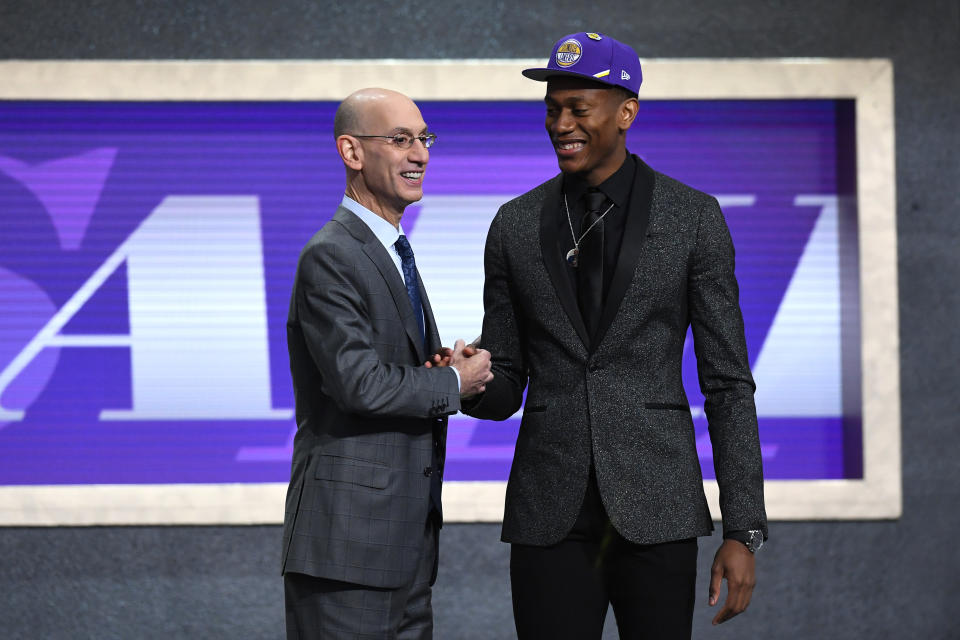The NBA draft is broken, and here's how the league might go about fixing it
It has been a year since Houston Rockets general manager Daryl Morey proposed swapping the draft and free agency on the NBA calendar, and Thursday’s feverish confusion over which team was actually on the clock is expected to reignite that discussion and others as the league office discusses changes in the coming weeks.
It is not so much the parade of prospects walking across the stage to greet NBA commissioner Adam Silver in the wrong hat that is most concerning. That is as awkward for the viewer as it is for the draftee, but it has also been happening for as long I can remember. (Shoutout Chris Webber’s Orlando Magic cap.) The bigger concern for the league is the number of players who are in limbo this weekend.
The Anthony Davis trade alone left four players without an official NBA home on Friday, including lottery picks De’Andre Hunter and Jaxson Hayes. Technically, the Los Angeles Lakers still own the rights to Hunter, who will go to the Atlanta Hawks by way of the New Orleans Pelicans, but the deal cannot be processed until July 6.
🤐🤐🤐🤐
— Atlanta Hawks (@ATLHawks) June 21, 2019
There are small-scale implications, like the fact that the Hawks must wait two weeks to even acknowledge their selection of Hunter, much less introduce him to their fan base. Same goes for Brandon Clarke and the Memphis Grizzlies. But there are bigger-picture problems, too. Clarke and Hunter will not be in uniform for Memphis and Atlanta when summer-league season opens as early as July 1.
In other words, however inconsequential it may seem in the long run, the integration of several handful of players into their teams is delayed until the league can sort out salary-cap figures for the 2019-20 season and process trades that depend on them. Their development, even if by two weeks, is stalled due to a scheduling conflict.
Some minor deals are delayed only for an hour or two on draft night, but every so often teams agree to the framework of trades that cannot be completed until the NBA calendar turns following the free-agency moratorium in the first week of July. It just so happens that two such trades — those involving Davis and Mike Conley — involved four first-round picks on Thursday. The league recognizes that two stars are not often traded in the window between the Finals and draft day, but the fact that it happened this year could expedite upcoming discussions about the process.
There are other reasons the Houston Rockets raised the idea last year of swapping the draft and free agency, akin to how the NFL operates. As ESPN’s Zach Lowe noted, if free agency were to come first, organizations would have a better idea of team needs entering the draft, and they may not be so averse to taking on salary in trades that could limit cap space that may go unspent if they cannot get their man.
For example, might the Brooklyn Nets have kept their first-round pick instead of moving into the second round for salary cap-clearing reasons if they knew for sure whether or not Kyrie Irving and Kevin Durant were coming together in free agency?

The downside is that everything still gets delayed. Accountants had a tough enough time moving the start of free agency up six hours to 6 p.m. on June 30, because every hour is precious in the painstaking process of setting the salary cap. If you cannot start free agency until weeks after the season ends, that pushes the draft into early July and summer league later in the month. That is not ideal for anyone associated with the NBA who is accustomed to clearing the month of August.
The idea has been floated that the league could work off the previous year’s salary cap figure, start free agency soon after the Finals and keep the draft on a similar schedule. That might be more trouble than it is worth, considering it would have to be collectively bargained and might be a tough sell to both sides of the matter.
A more likely idea to be discussed in league circles over the next few weeks is the idea of conducting a trade call between teams and NBA executives that would set the framework of a deal prior to the draft, while still not making it official until the start of the next calendar year. As of now, that call would not happen until the end of the moratorium. This gives everybody a firm understanding of the parameters of a deal, while allowing players to wear the right hats and teams to acknowledge their draftees. It’s also a much easier conversation to have with the players’ association.
This would clear up a lot of the confusion for fans watching on draft night who have no idea whether their favorite team actually drafted the guy wearing the same hat. That is a very real concern for the league office that became more so on Thursday.
Along those same lines, there is expected to be further discussions to improve the viewing experience on draft night. As an industry of independent draft shows pop up online, like ours at Yahoo Sports, which was at times multiple picks ahead of the TV broadcast in terms of analysis, the NBA is likely to discuss with ESPN a better way to incorporate its own reporting into the show. That way Rece Davis and Silver are not saying Matisse Thybulle is headed to the Boston Celtics, when anyone on Twitter already knew the 20th pick had been traded to the Philadelphia 76ers.
The idea of turning the first 14 picks into its own night of television, raised on Friday by Bill Simmons, who on his podcast made the point that this would give teams and their fans a night to process the results — and perhaps even allow for further trade considerations — has not yet been seriously considered by the NBA. But the league is open to the idea of turning the draft into a multi-day event, a la the NFL.
The idea here would then be turning the second round into something closer to the NCAA tournament selection show, where all the results are revealed after its conclusion. By my count, 11 second-round picks changed hands on Thursday, some of which had already been traded in the past, and only six of the 30 second-round picks were used by the team that originally owned them. As it unfolds on TV, it is impossible to have a firm grasp on who is going where and how it happened.
At the end of the day, the draft is a marketing opportunity, and if Thursday’s event showed us anything, it’s that the NBA is not maximizing the interest in the show. We should know soon from the league whether anything can be done about it by 2020.
– – – – – – –
Ben Rohrbach is a staff writer for Yahoo Sports. Have a tip? Email him at rohrbach_ben@yahoo.com or follow him on Twitter! Follow @brohrbach
More from Yahoo Sports:


